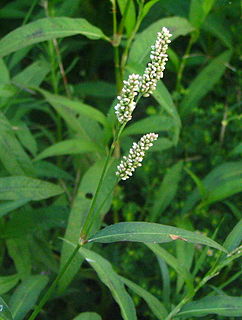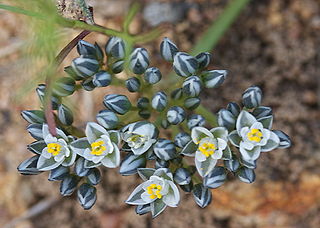
The Malvales are an order of flowering plants. As circumscribed by APG II-system, the order includes about 6000 species within 9 families. The order is placed in the eurosids II, which are part of the eudicots.

The Polygonaceae are a family of flowering plants known informally as the knotweed family or smartweed—buckwheat family in the United States. The name is based on the genus Polygonum, and was first used by Antoine Laurent de Jussieu in 1789 in his book, Genera Plantarum. The name may refer to the many swollen nodes the stems of some species have, being derived from Greek, poly meaning 'many' and gony meaning 'knee' or 'joint'. Alternatively, it may have a different derivation, meaning 'many seeds'.

Droseraceae is a family of carnivorous flowering plants, also known as the sundew family. It consists of approximately 180 species in three extant genera. Representatives of the Droseraceae are found on all continents except Antarctica.

Simmondsiaceae or the jojoba family is a family of flowering plants. The family is not recognized by all taxonomic systems, the single species, Simmondsia chinensis, often being treated as belonging to family Buxaceae.

Violales is a botanical name of an order of flowering plants and takes its name from the included family Violaceae; it was proposed by Lindley (1853). The name has been used in several systems, although some systems used the name Parietales for similar groupings. In the 1981 version of the influential Cronquist system, order Violales was placed in subclass Dilleniidae with a circumscription consisting of the families listed below. Some classifications such as that of Dahlgren placed the Violales in the superorder Violiflorae.

Plumbaginaceae is a family of flowering plants, with a cosmopolitan distribution. The family is sometimes referred to as the leadwort family or the plumbago family.

Drosophyllum is a genus of carnivorous plants containing the single species Drosophyllum lusitanicum. In appearance, it is similar to the related genus Drosera, and to the much more distantly related Byblis.

Dilleniaceae is a family of flowering plants with 11 genera and about 430 known species. Such a family has been universally recognized by taxonomists. It is known to gardeners for the genus Hibbertia, which contains many commercially valuable garden species.

Stegnosperma is a genus of flowering plants, consisting of three species of woody plants, native to the Caribbean, Central America, and the Sonoran Desert. These are shrubs or lianas, with anomalous secondary thickening in mature stems, by successive cambia.

The Dioncophyllaceae are a family of flowering plants consisting of three species of lianas native to the rainforests of western Africa.

The Molluginaceae are a family of flowering plants recognized by several taxonomists. It was previously included in the larger family Aizoaceae. The APG III system of 2009 made no change in the status of the family as compared to the APG II system of 2003 and the APG system of 1998, apart from a reassignment of several genera, such as the placement of Corrigiola and Telephium into Caryophyllaceae, Corbichonia in Lophiocarpaceae, Microtea into Microteaceae and Limeum in Limeaceae, because the family was found to be widely polyphyletic in Caryophyllales. In addition Macarthuria was found not to be related to Limeum as previously thought and thus it was placed in Macarthuriaceae, and similarly species formerly placed in Hypertelis, apart from type species Hypertelis spergulacea, a true Molluginaceae, were found to belong elsewhere and were described as Kewa in the family Kewaceae, named for the Royal Botanic Gardens Kew. Molluginaceae is still assigned to the order Caryophyllales in the clade core eudicots, although the generic circumscription is difficult because Mollugo is not monophyletic.

Barbeuia madagascariensis is a liana found only on the island of Madagascar.

Halophytum ameghinoi is a species of herbaceous plant endemic to Patagonia. It is the only species in the genus Halophytum. It is a succulent annual plant, with simple, fleshy, alternate leaves. The plants are monoecious, with solitary female flowers and inflorescences of male flowers on the same plant .
Rhabdodendron is a genus comprising two or three species of tropical South American trees.

Heliodinidae, commonly known as sun moths, is a family of small moths with slender bodies and narrow wings. Members of this family are found in most parts of the world. Heliodinid moths are brightly coloured day-flying moths. The base of the haustellum is bare. The scales on the head are compact and appear like a shield. Many Heliodinidae raise their hindlegs when resting but this is not a taxonomic feature and several genera like Epicroesa and Lamprolophus do not show this posture. Many Heliodinidae have the inner and outer spurs of the metatibia subequal. The larval host plants of the majority of species are in the Aizoaceae, Chenopodiaceae, Phytolaccaceae, Portulacaceae and Nyctaginaceae, all in the Order Caryophyllales. A few feed on Onagraceae, Araliaceae and Piperaceae. The pupae have long stiff hairs on their back sides.

Betalains are a class of red and yellow tyrosine-derived pigments found in plants of the order Caryophyllales, where they replace anthocyanin pigments. Betalains also occur in some higher order fungi. They are most often noticeable in the petals of flowers, but may color the fruits, leaves, stems, and roots of plants that contain them. They include pigments such as those found in beets.

Caryophyllales is a diverse and heterogeneous order of flowering plants that includes the cacti, carnations, amaranths, ice plants, beets, and many carnivorous plants. Many members are succulent, having fleshy stems or leaves. The betalain pigments are unique in plants of this order and occur in all its families with the exception of Caryophyllaceae and Molluginaceae.

The Anacampserotaceae are a family of plants proposed in the February 2010 issue of the journal Taxon. The family was described by Urs Eggli and Reto Nyffeler in their analysis of the polyphyly in the suborder Portulacineae. The new family and its circumscription was based on molecular and morphological data. The three recognized genera - Anacampseros, Grahamia, and Talinopsis - were formerly placed in the Portulacaceae and comprise a total of 36 known species. This family was accepted in the Angiosperm Phylogeny Group's 2009 publication of the APG III system.

Limeum is a genus of flowering plants. It includes 25 species.

Macarthuriaceae is a family of plants in the order Caryophyllales and consists of a single genus, Macarthuria.


















